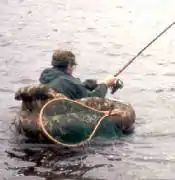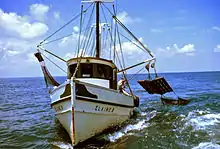Fishing weir
A fishing weir, fish weir, fishgarth[1] or kiddle[2] is an obstruction placed in tidal waters, or wholly or partially across a river, to direct the passage of, or trap fish. A weir may be used to trap marine fish in the intertidal zone as the tide recedes, fish such as salmon as they attempt to swim upstream to breed in a river, or eels as they migrate downstream. Alternatively, fish weirs can be used to channel fish to a particular location, such as to a fish ladder. Weirs were traditionally built from wood or stones. The use of fishing weirs as fish traps probably dates back prior to the emergence of modern humans, and have since been used by many societies around the world.
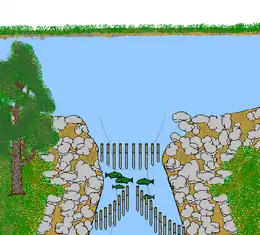
History
The English word 'weir' comes from the Anglo-Saxon wer, one meaning of which is a device to trap fish.[3] A line of stones dating to the Acheulean in Kenya may have been a stone tidal weir in a prehistoric lake, which if true would make this technology older than modern humans.[4] In Ireland, fish traps in association with weirs have been found that date from 8,000 years ago.[3] Stone tidal weirs were used around the world and by 1707, 160 such structures, some of which reached 360 metres in length, were in use along the coast of the Shimabara Peninsula of Japan.[5]
In medieval Europe, large fishing weir structures were constructed from wood posts and wattle fences. V-shaped structures in rivers could be as long as 60 m (200 ft) and worked by directing fish towards fish traps or nets. Such weirs were frequently the cause of disputes between various classes of river users and tenants of neighbouring land. Basket weir fish traps are shown in medieval illustrations and surviving examples have been found. Basket weirs are about 2 m (6.6 ft) long and comprise two wicker cones, one inside the other—easy for fish to get into but difficult to escape.[6]
In September 2014 researchers from University of Victoria investigated what may turn out to be a 14,000-year-old fish weir in 120 ft (37 m) of water off the coast of Haida Gwaii, British Columbia.[7]
Great Britain
In Great Britain the traditional form was one or more rock weirs constructed in tidal races or on a sandy beach, with a small gap that could be blocked by wattle fences when the tide turned to flow out again.
Wales
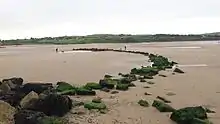

Surviving examples, but no longer in use, can be seen in the Menai Strait, with the best preserved examples to be found at Ynys Gored Goch (Red Weir Island) dating back to around 1842.[8] Also surviving are 'goredi' (originally twelve in number) on the beach at Aberarth, Ceredigion. Another ancient example was at Rhos Fynach in North Wales, which survived in use until World War I.[9] The medieval fish weir at Traeth Lligwy, Moelfre, Anglesey was scheduled as an Ancient Monument in 2002.[10]
England
Fish weirs were an obstacle to shipping and a threat to fish stocks, for which reasons over the course of history several attempts were made to control their proliferation. The Magna Carta of 1215 includes a clause embodying the barons' demands for the removal of the king's weirs and others:
All fish-weirs shall be removed from the Thames, the Medway, and throughout the whole of England, except on the sea coast.[11]
A statute was passed during the reign of King Edward III (1327–1377) and was reaffirmed by King Edward IV in 1472[12] A further regulation was enacted under King Henry VIII, apparently at the instigation of Thomas Cromwell, when in 1535 commissioners were appointed in each county to oversee the "putting-down" of weirs. The words of the commission were as follows:[13]
All weirs noisome to the passage of ships or boats to the hurt of passages or ways and causeys (i.e. causeways) shall be pulled down and those that be occasion of drowning of any lands or pastures by stopping of waters and also those that are the destruction of the increase of fish, by the discretion of the commissioners, so that if any of the before-mentioned depend or may grow by reason of the same weir then there is no redemption but to pull them down, although the same weirs have stood since 500 years before the Conquest.
The king did not exempt himself from the regulation and by the destruction of royal weirs lost 500 marks in annual income.[14] The Lisle Papers provide a detailed contemporary narrative of the struggle of the owners of the weir at Umberleigh in Devon to be exempted from this 1535 regulation.[15] The Salmon Fisheries Act 1861 (relevant provisions re-enacted since) bans their use except wherever their almost continuous use can be traced to before the Magna Carta (1215).
North America

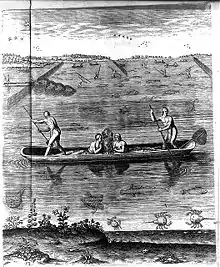
In Virginia, the Native Americans built V-shaped stone weirs in the Potomac River and James River. These were described in 1705 in The History and Present State of Virginia, In Four Parts by Robert Beverley Jr:
At the falls of the Rivers, where the Water is shallow, and the Current strong, the Indians use another kind of Weir thus made. They make a Dam of loose stone where of there is plenty on hand, quite across the River, leaving One, Two or more Spaces or Tunnels, for the water to pass thro': at the Mouth of which they set a Pot of Reeds, Wove in form of a Cone, whose Base is about Three Foot, and in Perpendicular Ten, into which the Swiftness of the Current carries the Fish, and wedges them in fast, that they cannot possibly return.[16]
This practice was taken up by the early settlers but the Maryland General Assembly ordered the weirs to be destroyed on the Potomac in 1768. Between 1768 and 1828 considerable efforts were made to destroy fish weirs that were an obstruction to navigation and from the mid-1800s, those that were assumed to be detrimental to sports fishing.[16]
In the Back Bay area of Boston, Massachusetts, wooden stake remains of the Boylston Street Fishweir have been documented during excavations for subway tunnels and building foundations. The Boylston Street Fishweir was actually a series of fish weirs built and maintained near the tidal shoreline between 3,700 and 5,200 years ago.
Natives in Nova Scotia use weirs that stretch across the entire river to retain shad during their seasonal runs up the Shubenacadie, Nine Mile, and Stewiacke rivers, and use nets to scoop the trapped fish. Various weir patterns were used on tidal waters to retain a variety of different species, which are still used today. V-shaped weirs with circular formations to hold the fish during high tides are used on the Bay of Fundy to fish herring, which follow the flow of water. Similar V-shaped weirs are also used in British Columbia to corral salmon to the end of the "V" during the changing of the tides.
The Cree of the Hudson Bay Lowlands used weirs consisting of a fence of poles and a trap across fast flowing rivers. The fish were channelled by the poles up a ramp and into a box-like structure made of poles lashed together. The top of the ramp remained below the surface of the water but slightly above the top of the box so that the flow of the water and the overhang of the ramp stopped the fish from escaping from the box. The fish were then scooped out of the box with a dip net.[17]
South America
A large series of fish weirs, canals and artificial islands was built by an unknown pre-Columbian culture in the Baures region of Bolivia, part of the Llanos de Moxos.[18] These earthworks cover over 500 square kilometres (190 sq mi), and appear to have supported a large and dense population around 3000 BCE.[19] Stone fish weirs were in use 6,000 years ago in Chiloé Island off the coast of Chile.[20]
Asia and Oceania
Taiwan had the world's largest tidal weirs that trap fish at low tide and were in use until the 1950s. Yap in the western pacific has the longest continual use of fish weirs made of stones since before European contact. [21]
Gallery
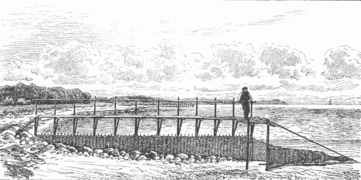 19th-century fishing weir used to trap eels on the Danish coast
19th-century fishing weir used to trap eels on the Danish coast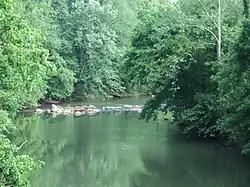 The Martinsville Fish Dam Virginia, an historic Native American Indian fishing weir built with rocks
The Martinsville Fish Dam Virginia, an historic Native American Indian fishing weir built with rocks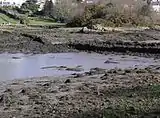 Remains of an ancient stone fishing weir in the tidal Menai Strait in Wales
Remains of an ancient stone fishing weir in the tidal Menai Strait in Wales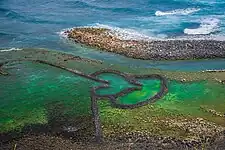 Double Heart fishing weir in Penghu, Taiwan
Double Heart fishing weir in Penghu, Taiwan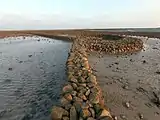 Fishing weir, Penghu County
Fishing weir, Penghu County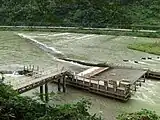 Fishing weir on the rapidly flowing Mogami River in Japan
Fishing weir on the rapidly flowing Mogami River in Japan Fishing weirs using baskets at a river waterfall, Democratic Republic of the Congo
Fishing weirs using baskets at a river waterfall, Democratic Republic of the Congo Ancient V-shaped fishing weir at Countisbury Cove, Somerset
Ancient V-shaped fishing weir at Countisbury Cove, Somerset
References
- "Fishgarth". Merriam Webster online. Merriam Webster Inc. Retrieved 3 July 2014.
- "The British Salmon Fisheries". Fishing Excerpts, Volume 3. January 6, 2009. p. 752 – via Google Books.
{{cite book}}:|journal=ignored (help) - Jecock, Marcus. "River Fisheries and Coastal Fish Weirs" (PDF). Introductions to Heritage Assets. English heritage. Retrieved 3 July 2014.
- Clark, J. Desmond (1960). "Human Ecology During Pleistocene and Later Times in Africa South of the Sahara". Current Anthropology. 1 (4): 317. doi:10.1086/200115. JSTOR 2739766. S2CID 145339570.
- Nishimura, Asahitaro (1975). "Cultural and social change in the mode of ownership of stone tidal weirs". In Richard W. Casteel; Jean-Claude Passeron; Walter de Gruyter (eds.). Maritime Adaptations of the Pacific. pp. 77–88. ISBN 9783110879902.
- Shooting and Fishing the Trent Archived 2007-01-25 at the Wayback Machine, ancient fish traps.
- "Canada's Oldest Archaeological find unearthed on Haida Gwaii". Global T.V. Retrieved 24 September 2014./
- Anon. "Ynys Gorad Goch". Menai Heritage. Menai Bridge Community Heritage Trust. Retrieved 30 September 2018.
- Reid, Ian (2001): "Rhos-on-Sea Heritage Trail". BBC Wales North West website retrieved 7 August 2007.
- Anon. "Traeth Lligwy Fish Weir". Ancient monument. Retrieved 24 February 2018.
- The Text of Magna Carta, see paragraph 33.
- Byrne, Muriel St. Clare, (ed.) The Lisle Letters, 6 vols, University of Chicago Press, Chicago & London, 1981, vol.2, p.622, quoting Luders, A., Statutes of the Realm, vol.2, 1810–28, pp.439–42
- Byrne, Muriel St. Clare, (ed.) The Lisle Letters, 6 vols, University of Chicago Press, Chicago & London, 1981, vol.2, p.628
- Byrne, Muriel St. Clare, (ed.) The Lisle Letters, 6 vols, University of Chicago Press, Chicago & London, 1981, vol.2, pp.623-627
- Byrne, 1981, 6 vols., the matter is referred to in all 6 vols
- Hranicky, William (1 April 2009). Material Culture from Prehistoric Virginia. Vol. 1. Authorhouse. ISBN 978-1438968490.
- Lytwyn, Victor P. (1 Jan 2002). "TheLlowland Cree and the Land". Muskekowuck Athinuwick: Original People of the Great Swampy Land. University of Manitoba Press. pp. 93, 94. ISBN 9780887553462.
- Erickson, Clark (2000): "An artificial landscape-scale fishery in the Bolivian Amazon". Nature, 408(6809):190–193
- Erickson, Clark (2000b): "AN ARTIFICIAL LANDSCAPE-SCALE FISHERY IN THE BOLIVIAN AMAZON" Archived 2008-01-17 at the Wayback Machine University of Pennsylvania website retrieved 12 Oct. 2007
- Ramirez-Aliaga, Jose Miguel (2011). "The Mapuche Connection". In Terry L. Jones; et al. (eds.). Polynesians in America: Pre-Columbian Contacts with the New World. AltaMira Press. p. 107.
- Billock, Jennifer (13 September 2017). "These Massive Land Art Constructions Are Actually Ancient Fishing Weirs". Smithsonian. Retrieved 15 September 2017.
External links
- Prehistoric Fishweirs in Eastern North America – master's thesis on fish weirs
